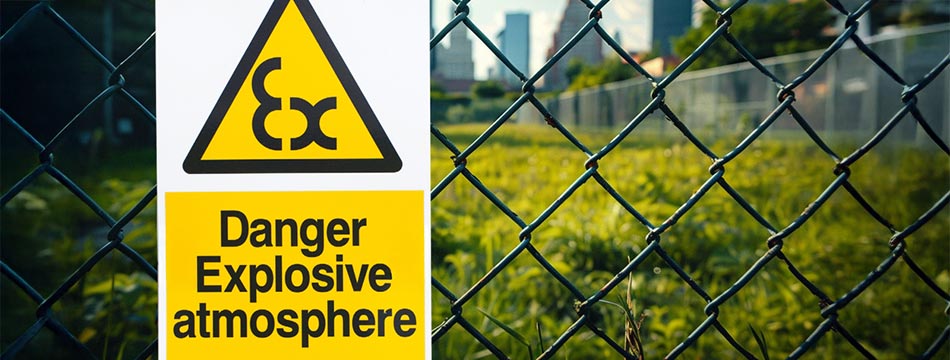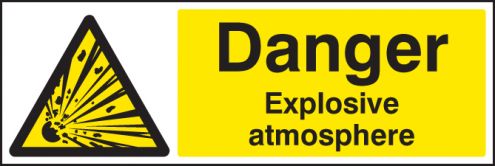
We all know the importance of testing various items and applications. Over time they might become damaged, work less efficiently, or - in the worst case scenario - injure someone who's working around them. Testing stops this process, but in certain environments, extra precautions must be taken when testing is carried out.
Intrinsic safety refers to devices or equipment that is to be used in hazardous environments that is designed not to cause ignition in the immediate atmosphere. Conventional test equipment, which works commonly with voltages and other power to generate test results, could ignite the atmosphere around the tester, causing an explosion. This is why using intrinsically safe equipment in certain environments is of paramount importance - neglecting to use the right equipment could result in an ignition, an explosion and injuries or even death to those in the area.
Intrinsic safety is defined as "equipment and wiring which is incapable of releasing sufficient electrical or thermal energy under normal or abnormal conditions to cause ignition of a specific hazardous atmospheric mixture in its most easily ignited concentration". Intrinsically safe equipment is specially designed to limit available energy. This in turn limits the risk of a spark, short-circuit or other incidents occurring that could ignite combustible elements in an atmosphere (many gasses and types of dust are combustible, and can be invisible to the naked eye). Using a conventional meter or other piece of testing equipment in the same way could result in these problems happening, and in environments where intrinsic safety is important an explosion could be even more dangerous due to the nature of the environment itself.
Environments where intrinsic safety are of the utmost importance include oil rigs (as sparks could ignite oil or other chemicals), mines and even factories that produce sucrose and sugar products. We really can't stress enough the importance of NOT using normal test equipment in any environment that is defined as hazardous due to risk of ignition. Even using something as simple as a camera in ignitable environments can be enough to cause a combustion in the air, and it is extremely important that any cameras or test equipment used in these environments is specially designed to not cause combustion.
Explosive Atmospheres
Under the rules and regulations of The Dangerous Substances and Explosive Atmospheres Regulations 2002 (DSEAR) employers are responsible for eliminating or controlling the risks from explosive atmospheres in working environments.
Note: This does not refer directly to explosions caused intentionally in construction work etc, but rather refers to combustible environments as a result of work practices.
[caption id="attachment_393" align="aligncenter" width="495"] An example of a sign designed to tell users about the threat of explosive atmospheres[/caption]
An example of a sign designed to tell users about the threat of explosive atmospheres[/caption]
If there is absolutely any risk of combustion in an environment it is extremely important that a risk assessment is carried out based around the environment's ignition. The employer, or responsible person, must do the following in order to assess explosion (ignition) risks:
- Assess the hazardous properties of dangerous substances
- Assess the amount of dangerous substances involves
- Define the work processes, interactions, cleaning, repair and maintenance that is to take place involving substances or equipment in the environment
- Define the temperatures and pressures at which the dangerous substances will be handled
- Assess and implement a containment system that controls and prevents liquids, gasses, vapours and dust from escaping into an area where it shouldn't be present
- Assess whether explosive atmospheres can be created within enclosed systems such as containment systems, storage vessels or enclosed plants
- Assess whether there are extra measures included to ensure that explosive atmospheres do not persist indefinitely (such as ventilation)
Based on this assessment the employer can categorise the environment as a 'Zone' as defined under the rulings by DSEAR. Depending on the zone the risk of explosion or ignition may be higher, and greater steps must be taken in order to prevent explosions from occurring.
The zones are defined as follows:
Gases, Vapours and Mists Zone Classifications
- Zone 0 - A place in which an explosive atmosphere consisting of a mixture with air of dangerous substances in the form of gas, vapour or mist is present continuously or for long periods or frequently
- Zone 1 - A place in which an explosive atmosphere consisting of a mixture with air of dangerous substance in the form of gas, vapour or mist is likely to occur in normal operation occasionally
- Zone 2 - A place in which an explosive atmosphere consisting of a mixture with air of dangerous substances in the form of gas, vapour or mist is not likely to occur in normal operation but, if it does occur, will persist for a short period only
In this zone classification, Zone 0 is the most dangerous of the three, while Zone 2 is less dangerous, but steps must be taken (such as using intrinsically safe equipment) in order to prevent ignition.
Different classifications are also given to combustible environments which are at risk because of dust.
Dust Zone Classifications
- Zone 20 - A place in which an explosive atmosphere in the form of a cloud of combustible dust in air is present continuously, or for long periods or frequently
- Zone 21 - A place in which an explosive atmosphere in the form of a cloud of combustible dust in air is likely to occur in normal operation occasionally
- Zone 22 - A place in which an explosive atmosphere in the form of a cloud of combustible dust in air is not likely to occur in normal operation but, if it does occur, will persist for a short period only
Regardless of which classification is given to the environment it is important that measures taken to prevent explosions including containment, ventilation and the use of intrinsically safe equipment are implemented and enforced continuously throughout the operation of that working environment. This 'verification' process must be done by a person or organisation competent to consider the particular risks in the workplace, and the adequacy of the explosion control and other measures put in place.
Types of Intrinsically Safe Test Equipment
There are many different types of intrinsically safe devices. They're not necessarily all types of test equipment either - many are containment measures and other devices designed to not cause ignitions. Test equipment is however still one of the most common types of intrinsically safe equipment, primarily due to the fact that testing needs to be carried out regularly on machinery and other applications inside explosion-risk environments.
Here's a few examples of the different intrinsically safe equipment types:
- Intrinsically Safe multimeters
- Intrinsic safety cameras (even something as simple as a camera flash can be enough to cause combustion in certain environments)
- Intrinsically safe thermal imaging cameras - a relatively recent invention, some thermal cameras are now suitable for carrying out heat evaluation in explosion risky environments
- Intrinsically safe calibrators - includes pressure and multifunction calibrators
Intrinsically safe equipment is generally given what's known as an 'Ex' rating and they usually come accompanied with a symbol that looks like this:
'Ex' isn't just a basic symbol given to every type of intrinsically safe equipment however. Instead the 'Ex' merely refers that the device offers some form of protection against explosions, but it is also accompanied by another symbol depending upon the actual type of special measures taken to prevent the equipment from causing ignition.
The following table gives more information on the types of protection that can be applied to test equipment (and other intrinsically safe devices):
| Gases/Vapours | Gases/Vapours | Dusts | |
|---|---|---|---|
| Type of Protection | Electrical Equipment | Non-Electrical Equipment | Electrical Equipment |
| Flameproof Enclosure | Yes | Yes | - |
| Enclosed Break Device | Yes | - | - |
| Non-incendive Component | Yes | - | - |
| Pressurised Apparatus | Yes | Yes | Yes |
| N-Pressurisation | Yes | - | - |
| Powder Filling | Yes | - | - |
| Oil Immersion | Yes | Yes | - |
| Increased Safety | Yes | - | - |
| Non-Sparking Apparatus | Yes | - | - |
| Encapsulation | Yes | - | Yes |
| Hermetically Sealed Device | Yes | - | - |
| Encapsulated Device | Yes | - | - |
| Sealed Device | Yes | - | - |
| Protection by Enclosure | - | - | Yes |
| Intrinsic Safety | Yes | - | Yes |
| Energy Limited Circuit | Yes | - | - |
| Restricted Breathing Enclosure | Yes | Yes | - |
| Protection by Constructional Safety | - | Yes | - |
| Protection by Control of Ignition Sources | - | Yes | - |
As can be seen here in the table, different types of protection are available for explosion-proof equipment. Intrinsic safety is not always applicable to a product, and other types of protection may also be used as a preventative measure.
The next section of this article looks at the protection types outlined above in greater detail.
Flameproof Enclosure
Marking: "Ex d" II 2 G in accordance with IEC 60079-0
This protection type is made to fully enclosure parts which could potentially cause an internal explosion inside the equipment, and thusly cause the environment to combust as well. The casing must be strong enough to withstand this internal combustion and prevent transmission of the explosion to the explosive atmosphere around the enclosure.
Protection by Enclosure
Marking: "Ex td" in accordance with IEC 61241-0
The delicate internal components of a system are sealed extremely tightly, preventing any form of combustible dust from entering into the system. The surface temperature of the overall enclosure is also limited.
Enclosed Break Device
Marking: "Ex nC" II 3G in accordance with IEC 60079-0
Contacts that open/close circuitry that could potentially cause an ignition and transfer this to an explosive environment must be sealed in such a manner that the enclosure will withstand an internal explosion of a mixture of subgroup IIA, IIB or IIC without being damaged.
Non-Incendive Component
Marking: "Ex nC" in accordance with IEC 60079-0
Variant of the Ex n type of protection with contacts which close and open a circuit potentially able to trigger an explosion, where the contact mechanism or the enclosure into which the contacts are enclosed is designed in such a way that the ignition of a mixture of subgroup IIA, IIB or IIC in the surrounding environment is prevented as long as defined operating conditions apply.
Pressurised Apparatus
Marking "Ex p" II 2 G in accordance with IEC 60079-0
Marking "Ex pD" II 2 D in accordance with IEC 61241-0
Marking "p" II 2 G/D in accordance with EN 13463-1
A type of ignition shield gas is kept at a pressure above atmospheric pressure to prevent the ingress of the surrounding atmosphere into the enclosure of the piece of electrical equipment. Overpressure is maintained with or without constant flushing of the protective gas.
n-Pressurisation
Marking "Ex pz" II 3 G in accordance with IEC 60079-0
A protective gas inside an enclosure prevents ignition and the formation of an explosive atmosphere by maintaining a pressure greater than that of the surrounding atmosphere.
Powder Filling
Marking "Ex q" II 2 G in accordance with IEC 60079-0
A fine powder is inserted within the enclosure. This stops electrical arcs from forming, and this in turn stops ignition of the outside atmosphere. The system must have no risk of ignition by flames, nor by increased temperatures at the surface of the enclosure.
Oil/Liquid Immersion
1) Marking "Ex o" II 2 G in accordance with IEC 60079-0
2) Marking "k" II 2 G in accordance with EN 13463-1
The parts inside the system which might result in an explosion when exposed to a combustible environment are immersed in oil or other non-flammable, insulating liquid that prevents gasses and vapours above the oil level from being ignited by sparks or electrical arcs below the oil level. This also applies to hot residual gasses from the switching process or by hot surfaces (such as those on a resistor).
Increased Safety
Marking "Ex e" II 2 G in accordance with IEC 60079-0
The system uses additional measures to provide a high level of protection. This must ensure reliable prevention of unacceptably high temperatures, sparks or electrical arcs, both internally and externally.
Non-Sparking Apparatus
Marking "Ex nA" II 3 G in accordance with IEC 60079-0
The apparatus is designed to prevent high temperatures, sparks and electrical arcs both on the external and internal parts of the equipment, provided that the normal operation of the equipment is not meant to use any of these parameters.
Constructive Safety
Marking "c" II 2 G/D in accordance with EN 13463-1
The system is constructed in order to make sure they cannot turn into an ignition source under normal operation or in the case of faults.
Encapsulation
Marking "Ex m" II 2 G in accordance with IEC 60079-0
Marking "Ex mD" II 2 D in accordance with IEC 61241-0
Potentially ignitable parts are potted in order to stop the spread of sparks of heat into a combustible atmosphere. The parts are encapsulated in a compound resistant to physical - especially electrical, thermal and mechanical - and chemical influences.
Hermetically Sealed Device
Marking "Ex nC" II 3 G in accordance with IEC 60079-0
The equipment is designed to stop the external atmosphere from entering. It can include cavities.
Encapsulated Device
Marking "Ex nC" II 3 G in accordance with IEC 60079-0
Similar to the type of encapsulation used in a casting compound, this can also include cavities and must prevent the outer atmosphere from entering the system.
Sealed Device
Marking "Ex nC" II 3 G in accordance with IEC 60079-0
The equipment may include cavities, which are fully enclosed similar to the encapsulation type of protection so that ingress of the outer atmosphere is prevented.
Intrinsic Safety
Marking "Ex i" II 2 G in accordance with IEC 60079-0
Marking "Ex iD" II 2 D in accordance with IEC 61241-0
The equipment must only contain circuits that meet intrinsic safety requirements. The circuit must therefore causes no spark or thermal effect under test conditions, and should not be able to ignite explosive atmospheres of subgrounds IIA, IIB and IIC.
Inherent Safety
Marking "g" II 2 G/D in accordance with IEC 60079-0
The processes within the device, i.e. relative speed and the striking energy, are at such a low dynamic level that an ignition of flammable mixtures is excluded. The standard is still in its initial draft state, such devices may be omitted from the validity scope of the Directive 94/9/EC due to the fact that they bear no potential ignition source.
Energy Limited Circuit
Marking "Ex nL" II 3 G in accordance with IEC 60079-0
These are circuits in which no spark or thermal effect occurring under the test conditions laid down in the standard can ignite the explosive atmosphere of subgroups II A, II B and II C or of an air/dust mixture.
The test conditions cover normal operation and certain fault conditions stipulated in the standard.
The permissible currents or voltages exceed those stipulated for the intrinsic safety type of protection.
Restricted Breathing Enclosure
Marking "Ex nR" II 3 G in accordance with IEC 60079-0
Marking "fr" II 3 G in accordance with EN 13463-1
The enclosure is designed to stop gas ingress.
Protection by Control of Ignition Sources
Marking "b" II 2 G/D in accordance with EN 13463-1
This principle is under construction and not yet fully certified. It will work by monitoring ignition sources during normal operation.



